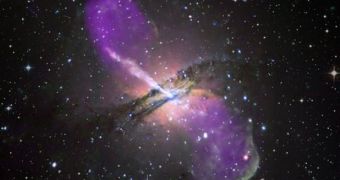The radio galaxy closest to Earth, Centaurus A, may feature at least two supermassive black holes at its core, a team of researchers has determined. Active galaxies such as this one have been found to contain two or more such structures at their cores more often than not.
In a study of seven such galaxies, four have been discovered to house two black holes in their active galactic nuclei (AGN), experts say. Our neighboring galaxy, which is located some 12 million light-years away from us, was recently observed in a new study.
The violet-colored areas in the attached image show the massive lobes of radio emissions that the galaxy is emitting into its surroundings. According to astrophysicists, infrared studies were responsible for determining the existence of two or more supermassive black holes at the cores of such objects.
NGC 5128 (Centaurs A) is located in the constellation Centaurus, and has a very active core, which emits radiation in a wide variety of wavelengths. The main engine for these emissions is the black hole's feeding process.
The dark behemoth is surrounded by a structure called an accretion disk, which is made up of matter that is being pulled towards the black hole, but which is orbiting it for now.
Gas and dust trapped in this disk heat to millions of degrees Fahrenheit under the tremendous friction that develops as the objects sucks them through the event horizon. As it finally fall into the dark object, the matter gets converted to a broad, multi-wavelength spectrum of radiation.
But, even if most of the galactic brightness is created by the black hole, some of it is also owed to the stars in the galaxy, and the evolution of the relationship between the two is still a mystery to experts.
In the new study, astronomers from the Harvard-Smithsonian Center for Astrophysics (CfA), led by Steve Willner and Giovanni Fazio, looked at seven radio galaxies using the NASA Spitzer Space Telescope. The galaxies were located between 7.5 and 12 billion light-years away from Earth.
It was during these IR investigations that the experts determined the existence of multiple supermassive black holes in four of the seven galaxies. Observations conducted with the NASA Fermi Gamma-Ray Telescope confirmed the discovery.
Astrophysicists also determined that under very specific conditions, light emitted at microwave energy levels can be boosted up to gamma-ray energies. This phenomenon does take place in Centaurus A, Daily Galaxy reports.

 14 DAY TRIAL //
14 DAY TRIAL //